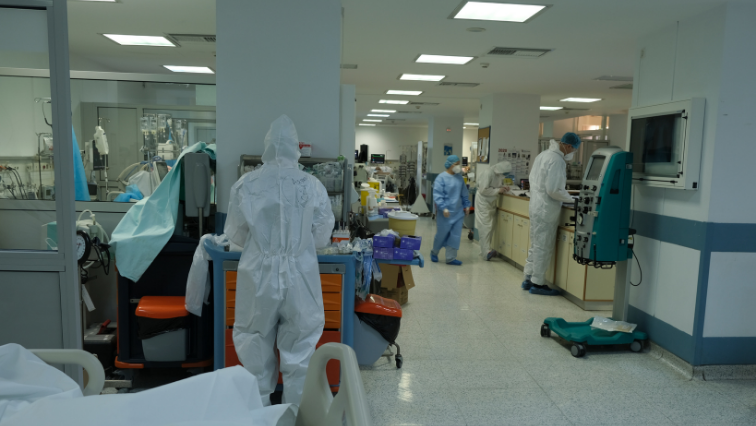Health Affairs, MAY 24, 2021
By Claudia A. Salzberg and Charles “Chip” Kahn
The current hospital quality programs and measures were not designed to contend with pandemics or public health emergencies of the magnitude we are experiencing. Nor are they equipped to manage the degree of aberration we are encountering in the underlying data. The COVID-19 pandemic has disrupted the health care system in ways that have affected patient-, provider-, and hospital-level decisions, behavior, and performance. This presents a significant problem to patients, hospitals, and the Centers for Medicare and Medicaid Services (CMS) alike—all of whom must rely on credible and consistent measures of quality.
In some cases, Medicare’s payment system adjusts hospital payment based on the quality of care the hospitals deliver. The Hospital Value-Based Purchasing (VBP) Program, the Hospital Readmissions Reduction Program (HRRP) and the Hospital-Acquired Condition (HAC) Reduction Program all link hospital payment to the quality of care. While COVID-19 impacted patient care in 2020 and 2021 (so far), the quality measures using 2020 data will impact these hospital quality reporting and payment programs for years to come (Fiscal Years 2022–25 [exhibit 1]).
Exhibit 1: Payment and reporting years impacted by COVID-19 across Medicare hospital quality and value-based programs

Source: Authors’ analysis of data from QualityNet.
CMS has gone to great lengths to grant reprieves and mitigate burden including in the recently released FY 2022 Medicare Hospital Inpatient Prospective Payment Proposed Rule (Proposed Rule) related to quality reporting and performance programs so that providers could focus on patient care during the height of the pandemic without worrying about being penalized for circumstances beyond their control. However, CMS still faces major challenges for years ahead in implementing adjustments, modifications, or exceptions to ensure proper use of these data in reporting and payment programs.
COVID-19 Introduced Complexity In Health Care Delivery
To understand the pandemic’s direct or indirect impact on quality measures, first consider how COVID-19 has infiltrated so many aspects of health care delivery.
Personal Protective Equipment, Resource Shortages, and Infection Controls
In the early months of the COVID-19 pandemic response, personal protective equipment (PPE) shortages impacted hospitals throughout the nation due to sudden surges in demand because of COVID-19-related care needs and severe disruptions in the PPE global supply chain. These shortages challenged the ability of hospitals and clinicians treating COVID-19 patients to keep caregivers safe while providing treatment during surges. To meet this challenge, providers complied with extended use and reuse protocols and went to great lengths to develop alternative treatment options so as to not deny needed treatment to any patient.
To reduce viral spread, conserve PPE, and reduce overall risk of hospital-acquired COVID-19, rigorous policies and infection control practices were modified in accordance with the Centers for Disease Control and Prevention recommendations to limit physical interactions. Infection control processes included the isolation of patients with COVID-19, the use of PPE when available, appropriate environmental disinfection, and visitor restrictions. Visitor restrictions required new policies and procedures regarding the visitation rights of patients to focus efforts on preventing and controlling infections. However, visitor restrictions have the additional effect of complicating and disrupting the process of engaging family members in decision making and providing additional support during the inpatient stay.
The lack of access to sufficient PPE coupled with the sudden surge of patients and the need to resort to alternative treatment options and strict infection controls substantially change clinical workflows, which in turn could impact measures and performance such as hospital-acquired infection (HAI) rates and patient wait times.
Capacity Constraints, Workforce Shortages, And Staffing Challenges
Staffing shortages have been a growing concern for the entire health care sector nationwide even before the COVID-19 pandemic with a looming forecast of a national deficit of the health care workforce by 2025. COVID-19 added to the strain requiring hospitals to ramp up staff for surges. Additionally, facilities faced workforce challenges as health care workers themselves fell sick or needed to quarantine after exposure to COVID-19. In addition, reports of anticompetitive pricing by nurse-staffing agencies during a time when hospitals have been in desperate need of caregivers further exacerbated staffing shortages in rural, smaller, and urban public hospitals. These challenges could impact measures around HAI rates, patient experience, efficiency, and cost reduction.
Delayed Or Deferred Care, Shifts In Resource Use, And Increased Patient Acuity
COVID-19 has affected both consumer behavior and health care use directly and indirectly. On March 18, 2020, CMS released recommendations to delay adult elective surgeries during the COVID-19 pandemic to conserve health care resources and reduce risk of transmission. By mid-March, hospitals began postponing or canceling elective cases, thus creating a backlog. This backlog along with individual patient shifts in care-seeking behavior, resulted in about 20 percent of adults in US households reporting they delayed or were unable to get care during the COVID-19 pandemic for serious health problems.
The COVID-19-related shift in the use of services and care provided in hospitals has led to increased average inpatient acuity and complexity. Furthermore, the indirect effects of delayed and deferred care have extended well past 2020 as delayed surgical diseases are allowed to progress into worse outcomes, increased infectious complications, higher mortality for patients across a range of diseases, and higher costs. Patients admitted into hospitals—both with COVID-19 and non-COVID-19—have had higher acuity, which will result in length-of-stay (LOS) with higher risk of increased use of femoral lines for central access and more use of urinary catheters, among others. Hospitals will be working on the backlog of delayed surgeries and the effects of delayed care well into 2021 in addition to addressing continuing cases of COVID-19.
Transfers Along The Care Continuum—How COVID-19 Upended Patient Acuity Distribution
With patient surges CMS granted new regulatory flexibilities that allowed hospitals to expand inpatient and intensive care unit (ICU) capacity. Those that could not expand further sought to redistribute patients and reduce system strain by coordinating transfers with other facilities that had more capacity, including long-term care and inpatient rehabilitation facilities. Efforts at redistribution and transfer of patients played an important role in the national efforts to maximize capacity and “level-load” demand for inpatient capacity. However, COVID-19 transfers were subject to delays due to logistical issues as patients were diverted. It is known that admission delays to ICUs can negatively affect patient outcomes and that emergency department crowding compromises quality of care, and safety and timeliness.
In addition, as the virus spread throughout skilled nursing facilities (SNFs), many decreased, or altogether halted, patient admissions, challenging efficient integration of care, which is known to reduce adverse outcomes, leaving those who should have been discharged to a SNF more vulnerable to readmission or alternatively with longer length-of-stay at the acute hospital.
In the absence of designated COVID-19 referral centers, the influx of critically and more complex COVID-19 patients were diverted to larger organizations with dedicated units to manage these patients. On the opposite end of the spectrum, small and rural organizations had to care for critically ill COVID-19 patients because options to transfer patients to the larger, dedicated units were not available.
Disproportionate COVID-19 Impact On Communities Of Color
Minority patients are three times more likely to contract COVID-19 than White individuals and have higher mortality rates. As some minorities are more likely to have undiagnosed chronic disease, this compounds the impact of COVID-19, increasing patient acuity and leading to longer length-of-stay and more intensive interventions than are experienced by White patients. The disproportionate COVID-19 impact on communities of color will have a direct effect on the outcomes of the hospitals serving these communities as patient acuity is disproportionately higher among patients in these populations. Exhibit 2 illustrates this and other COVID-19-related factors, which have introduced additional complexity in health care delivery.
Exhibit 2: Direct and indirect factors outside hospital control affecting measures of quality and performance

Source: Authors’ analysis.
The Known Unknown
COVID-19 Impact On Clinical Outcomes
Some information already is beginning to surface, but the complete extent of the impact is still unknown. For instance, there are already emerging correlations between COVID-19 and HAI as hospitals have been seeing triple triple-digit increases in HAIs such as central line-associated bloodstream infection rates during the pandemic. In addition, one study has found that rates of readmission or death were higher during the first 10 days after discharge following COVID-19 hospitalization suggesting a period of heightened risk of clinical deterioration. Furthermore, COVID-19 patients often have an extended length-of-stay due to inabilities to transfer or higher patient acuity, which potentially impacts measures regarding higher spending per Medicare beneficiary. Strict visitor restrictions focused on limiting viral spread disrupted family visits, which can affect measures of patient experience, exacerbate patient delirium, and contribute to higher fall rates. Finally, there are also concerns for higher rates of pressure injuries as a result of COVID-19.
COVID-19 Impact On Quality Measures
We still don’t know with a needed degree of precision how and to what extent COVID-19 has introduced uncertainty into the process of assessing hospital performance on various quality measures—but we know it exists, and CMS, to its credit, recognized this in the Proposed Rule. To further complicate matters, COVID-19’s impact on quality measurement is subject to at least four forces of variation: geographic variation in the spread of COVID-19; temporal variation in the spread of COVID-19; variation in the acuity of COVID-19 impact across populations; and variation in acuity of COVID-19 influx—all of which affected hospitals differently over the course of 2020, with potential longer-term impacts into 2021. In other words, there is as yet, no one-size-fits-all adjustment that accounts for the pandemic’s impact on each and every hospital.
All stakeholders have a responsibility, but what can and must happen is an explicit recognition by policy makers that the COVID-19 pandemic is a 100-year event that upends the carefully designed programs that have evolved over the past 10 years in terms of measure development and the data that drive performance, provider accountability, and patient decision making. The best short-term remedy requires that regulators first review each program individually—VBP Program, HRRP, and HAC Reduction Program—and identify the COVID-19-related data anomalies that would, absent any adjustment, yield inaccurate results and undermine the very purpose of the programs—to fairly hold providers financially accountable for their actions and to help patients choose providers based on the quality of care they can expect to receive based on past performance.
CMS took an important step in meeting this challenge by proposing a number of welcome, mitigating measures in its rule for fiscal year 2022 inpatient hospital payment. While there may be legal limits on how far regulators can go, inaction is not an option. Transparency requires that, at a minimum, the data issues and the policy implications must be publicly disclosed so that potential congressional action can be appropriately guided with stakeholder input. If the underlying laws need to be updated to provide regulators with the administrative flexibility they need to fully account for COVID-19 and future disruptions, congressional policy makers have a duty to work on those fixes.
While the full impact of COVID-19 on hospitals and health systems is yet to be understood, understanding the specific impact and predicting effects on data can help direct analyses, ensure we do not mislead patients with invalid data, nor incorrectly penalize hospitals for delivering care during a period of duress for which we cannot know the extent of the impact.
First published at
https://www.healthaffairs.org
https://www.healthaffairs.org/do/10.1377/hblog20210520.815024/full/?utm_medium=email&utm_source=hasu&utm_campaign=blog&utm_content=salzberg&utm_source=Newsletter&utm_medium=email&utm_content=Care+Delays+As+A+Result+Of+COVID-19%2C+Hospice+++More&utm_campaign=HASU%3A+5-30-21&vgo_ee=gUK6wW9wcZxZYwA%2FlteWDigFfsHX1KtEQ6so2w%2BCYb0%3D












